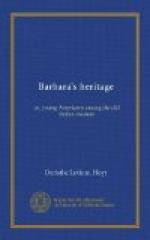“Yes,” replied Mr. Sumner, “it does not seem very reasonable to believe that they would have given way just enough to make the Tower lean as it does now, and that then it should remain stationary for so many centuries afterward. The Baptistery, or place for baptism, was formerly built in Italy separate from the Cathedral, as was the Campanile, just as we see them here. In northern countries and in more modern Italian cathedrals, we find all united in one building. The most interesting thing in this Baptistery is a magnificent marble pulpit covered with sculptures designed by Nicholas Pisano. To see it alone is worth a visit to Pisa. The long, low building that you saw beyond the other buildings is the Campo Santo, a name given to burial places in Italy, which, as you know, is a Latin term, and means ‘holy ground.’”
“I think it is a beautiful name,” said Bettina.
“Yes, there is a solemn rhythm about the words that pleases the ear rather more than does our word ‘cemetery,’” said Mr. Sumner.
“But there is something especially interesting about this Campo Santo, isn’t there?” queried Barbara, and added: “I do hope I shall remember all such things after I have really seen the places!”
“You surely will, my dear,” said Mrs. Douglas; “ever afterward they will be realities to you, not mere stories.”
Mr. Sumner resumed: “The Campo Santo of Pisa is the first one that was laid out in Italy, and it is still by far the most beautiful. It possesses the dimensions of Noah’s Ark, and is literally holy ground, for it was filled with fifty-three shiploads of earth brought from Mount Calvary, so that the dead of Pisa repose in sacred ground. The inner sides of its walls were decorated with noble paintings, many of which are now completely faded. We will come to see those which remain some day.”
“How strange it all is!” said Bettina. “How different from anything we see at home! Think of ships sent to the Holy Land for earth from Mount Calvary, and their coming back over the Mediterranean laden with such a cargo!”
“Only a superstitious, imaginative people, such as the Italians are, would have done such a thing,” said Mrs. Douglas; “and only in the mediaeval age of the world.”
“But,” she went on with a bright smile, “it is the same spirit that has reared such exquisite buildings for the worship of God and filled them with rare, sacred marbles and paintings that are beyond price to the world of art. I always feel when I come hither and see the present poverty of the beautiful land that the whole world is its debtor, and can never repay what it owes.”
Chapter III.
In Beautiful Florence.
For to the highest she
did still aspyre;
Or, if ought higher were then
that, did it desyre.
—SPENSER.
[Illustration: CHURCH OF THE ANNUNZIATA, FLORENCE.]




